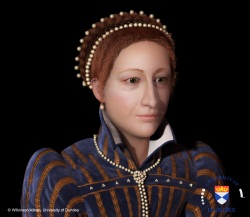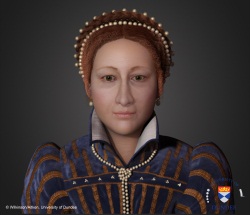27 June 2013
Face of Mary, Queen of Scots brought to life
photos credited to Caroline Wilkinson and Janice Aitken.

The face of Mary, Queen of Scots, as she would have looked at the time of her reign, has been brought back to life by a
renowned team of experts from the University of Dundee.
The team were commissioned to recreate a 3D virtual sculpture of Mary's face for a major new exhibition on her life that
opens at the National Museum of Scotland this Friday. They have previously worked on major projects to reconstruct the faces
of Bach, Cleopatra's sister, Simon of Sudbury and Richard III among others.

Professor Caroline Wilkinson, from the Forensic and Medical Art Research Group, worked from existing portraits and from what
is known of Mary's biography to reconstruct her face as it would have been following during her reign in Scotland from the
ages of 19 to 26, a period when there is no portrait record of her.
Professor Wilkinson created a head-and-neck model using the portraits of Mary as templates. The model was created using
3D modelling software and craniofacial templates before digital artist Janice Aitken sculpted clothing and hair then added
textures and lighting to create the finished image.
The result is a digital portrait of a 'striking face' shown from several different angles that reflects the enormous
challenges that Mary faced during her time as Queen of the Scots.
'There were no portraits painted during Mary's time in Scotland, but there were both before and after this period,'
explained Professor Wilkinson. 'Normally we would begin the process of craniofacial reconstruction by examining skeletal
remains, but of course we didn't have a skull to work from in this case so had to work from portraits earlier and later
than the depiction we were asked to create.
'This meant it was a very different challenge for me and the model is more of an artistic representation rather than
the scientific interpretation we would normally produce from skeletal remains. We had to get the facial proportions and
size of her features from portraits which, luckily, were from slightly different angles so we could look at her face
from more than one viewpoint.
'What we wanted to do was depict how she would have looked at the time she lived in Scotland. This was a difficult time
for her marked with illness, grief, miscarriage, and imprisonment so we wanted to show the stresses and strains of life on
her face because later portraits make her look significantly older than her years.
'She is not what you would describe as a classic beauty. Mary had quite a big nose and a strong chin so when
you describe her verbally she doesn't sound attractive, but the paleness of her skin, red hair, and strong features
meant she had a very striking appearance.'
Janice Aitken then put textures on the model and coloured the skin, hair and eyes to ensure it looked as realistic
as possible. She created a short movie of the face being shown from several different angles to give the viewer a more
complete impression of Mary during the time of her reign in Scotland.
Mary succeeded to the Scottish throne when her father, King James V died just days after her birth, meaning Scotland
was ruled by regents for most of her early years. She was sent to live in France aged just 5 and remained there until she
returned a widow 14 years later to find a country in the midst of serious religious strife.
Following a tumultuous reign, Mary was forced to abdicate in favour of her infant son and, after an unsuccessful attempt
to regain her throne, fled to England seeking the protection of her cousin Queen Elizabeth I. Perceiving as a threat, Mary
spent 18 years in custody before finally being found guilty of plotting to assassinate Elizabeth and was subsequently
executed.
The 'Mary, Queen of Scots' exhibition opens on Friday, 28th June at the National Museum of Scotland in Edinburgh and runs
until 17th November. It will explore the myth and reality that surround one of the most enigmatic and romanticised figures
in Scottish history through a unique gathering of paintings, jewellery, textiles, furniture, drawings, maps and documents.
Notes to editors:
The Forensic and Medical Art Research Group is a dynamic collaboration between the University's Centre for Anatomy & Human
Identification and Duncan of Jordanstone College of Art and Design.
The Group teaches a professional masters programme to support the transition from undergraduate study to the establishment
of professional practice within contemporary forensic and medical art fields.
For media enquiries contact:
Grant Hill
Press Officer
University of Dundee
Nethergate, Dundee, DD1 4HN
TEL: 01382 384768
E-MAIL: g.hill@dundee.ac.uk
MOBILE: 07854 953277 |

